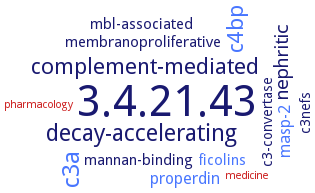Please wait a moment until all data is loaded. This message will disappear when all data is loaded.
Please wait a moment until the data is sorted. This message will disappear when the data is sorted.
C1 inhibitor
-
blocks the the classical pathway
-
C4b-binding protein
-
regulates assembly and decay of the classical pathway C3/C5 convertase 4times lower than the lectin pathway convertase
-
C4BP
-
effectively inhibits both C3 and C5 conversion
-
C4d antibody
-
blocks the the classical pathway
-
CN-
-
inhibits the aggregation of C4b and C2a and the activity of the active enzyme
complement receptor of immunoglobulin family
-
inhibits C5 conversion specifically
-
complement receptor type 1-related protein y
-
i.e. Crry, a mouse-specific complement inhibitor, expressed in astrocytes, microglia, and neurons of murine brain, in vivo and in vitro inhibition of C3 convertase, overview
-
Cp40
-
the inhibitor shows potent inhibition of C3 conversion
-
diisopropyl fluorophosphate
-
-
eculizumab
-
potently inhibits C5 conversion but leaves C3 conversion unaffected
-
EDTA
-
inhibits interaction between C4b and C2b
Efb-C
-
does not inhibit C3 convertase activity but C5 convertase activity
-
extracellular complement binding protein
-
does not inhibit C3 convertase activity but C5 convertase activity
-
extracellular complement-binding protein
-
Ecb, a potent complement inhibitor from Staphylococcus aureus, with strong antiinflammatory properties, inhibitory mechanism for blocking C3b-containing convertases, Efb-C and Ecb act on the bacterial surface, overview
-
extracellular fibrinogen-binding protein
-
Efb, a potent complement inhibitor from Staphylococcus aureus, with strong antiinflammatory properties, inhibitory mechanism for blocking C3b-containing convertases, Efb-C and Ecb act on the bacterial surface, overview
-
factor H
-
inhibits C5 conversion specifically
-
factor H related-protein 5
-
inhibits C5 conversion in a concentration-dependent manner
-
hepatitis virus C
-
inhibition of C3 convertase activity and C3b deposition onto bacterial membrane by hepatitis C virus, impairment of both C3 convertase and Factor I activity
-
mouse anti human factor B antibody
-
-
-
N-terminal long homologous repeat A of complement receptor type 1
-
responsible for dissociation of enzyme. Highest decay accelerating activity for mutant dimeric construct N-terminal long homologous repeat A (D109N/E116K)/N-terminal long homologous repeat A (D109N)
-
NH2-CD59-DAF-GPI
-
chimeric molecule, DAF: decay accelerating factor, GPI: glycosylphosphatidylinositol
-
NH2DAF-CD59-GPI
-
chimeric molecule, DAF: decay accelerating factor, GPI: glycosylphosphatidylinositol
-
OmCI
-
the inhibitor blocks C5 cleavage by interfering with convertase recognition far from C5a
-
Ornithodoros moubata complement inhibitory protein
-
potently inhibits C5 conversion but leaves C3 conversion unaffected
-
Pra1
-
i. e. Candida albicans complement regulator acquiring surface protein 2 or pH-regulated Ag 1. In the direct surrounding of the pathogen, inhibitor binds to fluid-phase C3, blocks cleavage of C3 to C3a and C3b and inhibits complement activation via the alternative and classical pathways. In addition, the release of the anaphylatoxins C3a and C5a, as well as C3b/iC3b surface deposition, is reduced. By reducing C3b/iC3b levels at the yeast surface, Pra1 decreases complement-mediated adhesion, as well as uptake of Candida albicans by human macrophages
-
rosmarinic acid
-
inhibition of C5 convertase by binding to component C3b
soluble complement receptor type 1
-
-
-
SSL7
-
the inhibitor blocks C5 cleavage by interfering with convertase recognition far from C5a
-
staphylococcal complement inhibitor
-
SCIN, a potent complement inhibitor from Staphylococcus aureus, with strong antiinflammatory properties, inhibitory mechanism for blocking C3b-containing convertases, overview
-
staphylococcal superantigen-like protein 7
-
inhibits C5 conversion
-
thioredoxin 1
-
Trx-1, but not an active site mutated form, inhibits both C3 and C5 classical convertase formation, mechanism, overview. Trx-1 is capable of inhibiting all classical and alternative convertases but its effect is more pronounced in inhibition of alternative ones
TT32
-
human complement receptor type 2 (CR2)/CR1 fusion protein
-
additional information

-
Kaposi's sarcoma-associated herpesvirus complement control protein inhibits complement through decay-accelerating activity of the classical C3 convertase and cofactor activity for factor I-mediated degradtion of C4b and C3b, as well as acting as an attachment factor for binding to heparan sulfate on permissive cells, overview
-
additional information
-
the C3b-specific antibody fragment S77 does not inhibit the classical pathway C5 convertase in human serum
-
additional information
-
addition of guinea pig serum in 40 mM EDTA initiates lysis of existing convertase complexes and excludes the possibility of de novo convertase formation
-



 results (
results ( results (
results ( top
top






